The Qualcomm Snapdragon 820 Performance Preview: Meet Kryo
by Ryan Smith & Andrei Frumusanu on December 10, 2015 11:00 AM EST- Posted in
- SoCs
- Snapdragon
- Qualcomm
- Snapdragon 820
CPU Performance, Cont
Having taken a look at Snapdragon 820 and the Kryo CPU from an architectural perspective, let’s look at our higher level benchmarks. We’ll start as always with the web benchmarks.

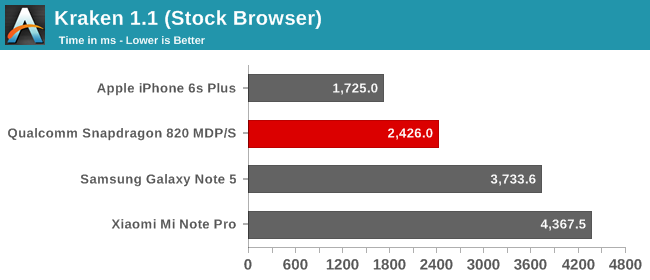
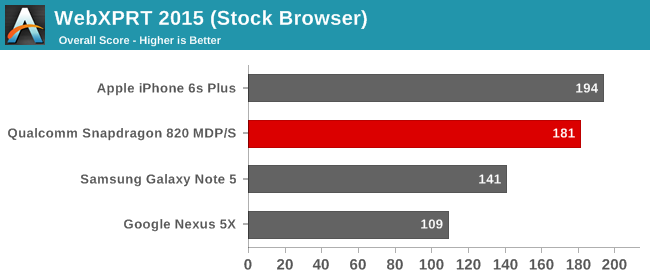
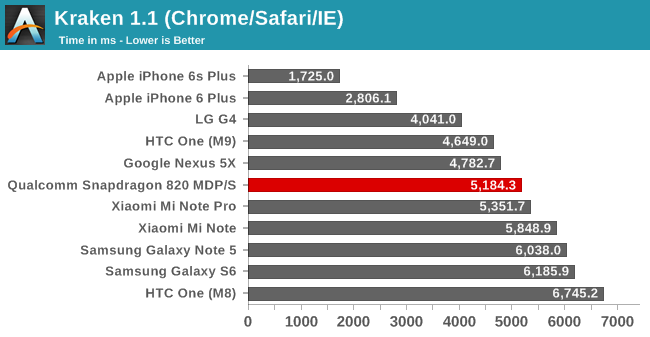

There are two things we can immediately take away from these results. The first is that currently Google Chrome is incredibly unoptimized for Kryo, and this is something Qualcomm was also quick to mention. We won’t wax on about this as there’s nothing to say we haven’t said before, but Chrome could certainly stand to implement optimized JS engines sooner.
Otherwise if we look at Qualcomm’s native browser, things are greatly improved. Relative to both the Exynos 7420 (A57) powered Note 5 and the Snapdragon 810 (A57) powered Mi Note Pro, the MDP/S shows a significant lead. In fact it pretty much blows past those devices in Kraken. However while it easily takes the top spot for an Android device, even with Qualcomm’s native browser the 820 isn’t going to be able to catch up to the iPhone 6s Plus and its A9 SoC.

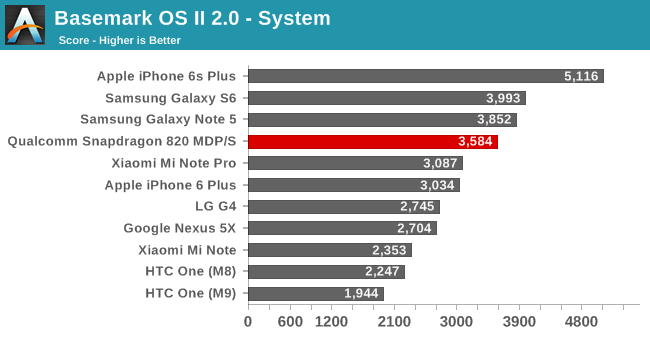
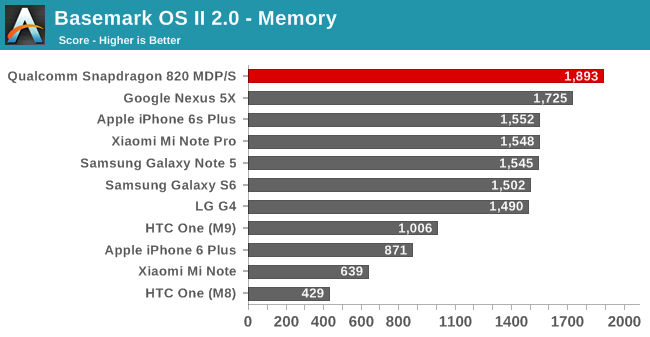
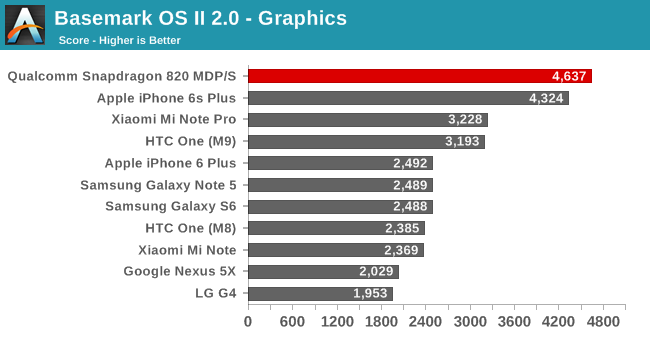
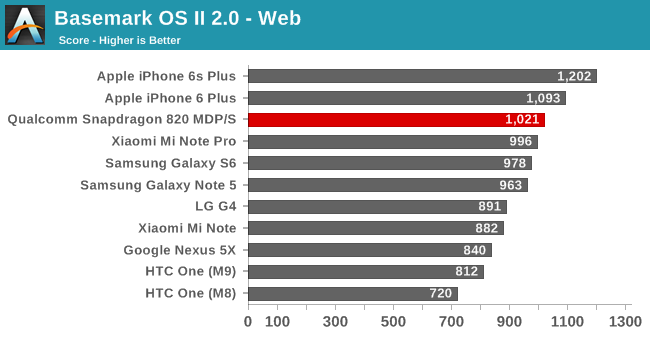
Basemark OS II 2.0 on the other hand is less consistent. The overall score again pegs the MDP/S as the best Android device, and by over 20%. However for reasons yet to be determined, the system score is still below the latest Samsung devices. Instead where the 820 shows a clear lead is with the storage (memory) score and the graphics score. In some cases it’s even beating the iPhone 6s Plus, though overall it will fall short.

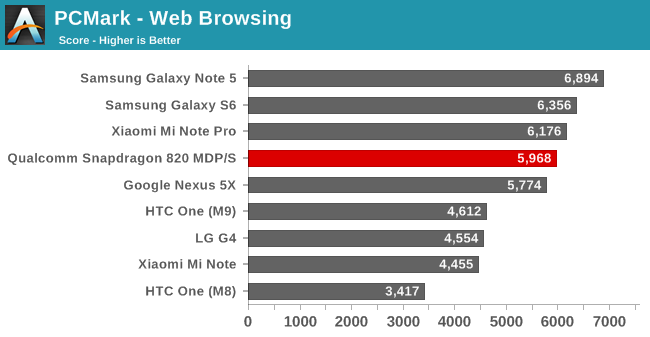
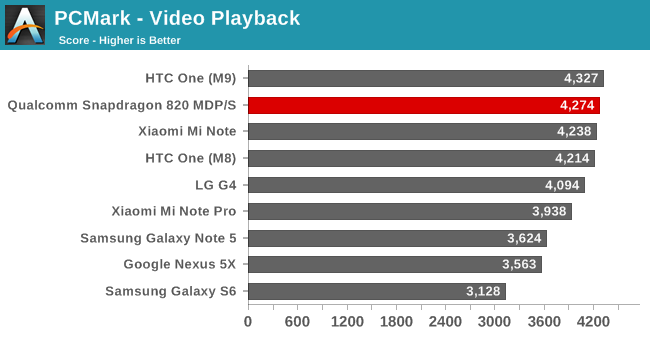
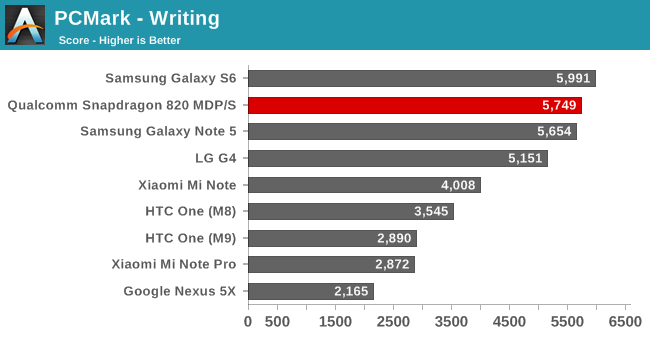
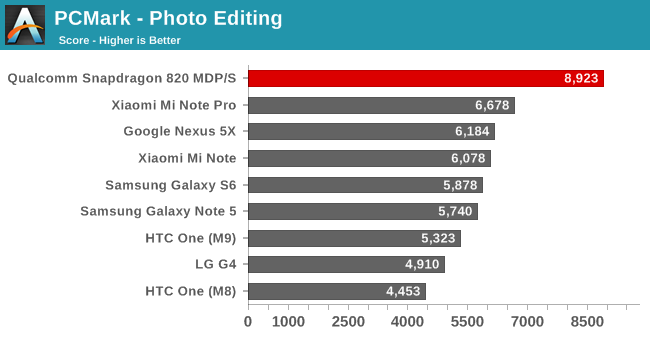
Our final system benchmark, PCMark, once again puts the MDP/S in a good light overall, while the individual sub-tests are more widely varied. Likely owing to the same optimization issues that dogged Chrome performance, web browsing performance trails the A57 devices. Meanwhile video playback closely trails the Snapdragon 810 powered HTC One M9, and writing performance won’t quite surpass the Galaxy S6. Where the 820 MDP/S makes up for it is in the photo editing score, which is through the roof. Here Qualcomm’s development device holds a 34% performance lead over the next-fastest device, the 810/A57 based Mi Note Pro.










146 Comments
View All Comments
jjj - Thursday, December 10, 2015 - link
I will remind you that here you got about the equivalent of 3 cores. So with 2 cores you would need 20% extra perf inside a 50% increase in per core power. So i was factoring in a certain amount of increase in power. If 20% increase in clocks with 50% increase in power is doable remains to be seen, we don't have enough data.That statement was about the core not about the device or the SoC and the core metrics are power,perf and area . The convos about the SoC and the device are different topics.
lucam - Friday, December 11, 2015 - link
Problem of your dogma is that you are comparing a prototype tablet versus a phone.That's why you are already mistaken...
michael2k - Thursday, December 10, 2015 - link
You ignore the fact that Apple has been shipping Kyro class HW since 2014 and Kyro isn't going to ship until 2016. A two year lead is commanding by any kind of definition.You talk as if only Qualcomm has access to 20% higher without also acknowledging that Apple already ships a very similar design, the A9X, that clocks 30% higher and has no L3 that is approximately 70% faster than the Kyro if we assume the Kyro performs similarly to the A8 at 1.4GHz.
jjj - Thursday, December 10, 2015 - link
You don't male any sense at all. Apple's old gen core wasn't all that fast while the ipad Pro had higher clocks because the form factor allows it. We are talking in a phone form factor.it is true that Apple's per core power consumption is a bit of an unknown so certain things are assumed.
Ryan is a fanboy and he tries to argue that fewer cores are better even he knows very well that more cores provide more computing power in the same TDP. AT worked hard to convince everybody that more core are better when Intel did it and now they are working hard to convince everybody that fewer cores are better when Apple does it because their OS is stuck in the past.
Pissedoffyouth - Thursday, December 10, 2015 - link
>Apple's old gen core wasn't all that fast while the ipad Pro had higher clocks because the form factor allows it. We are talking in a phone form factor.The 6s???????????????????????? That's a phone
>that more cores provide more computing power in the same TDP.
Oh yeah checking my facebook requires GPU like parallelism
lucam - Friday, December 11, 2015 - link
He will understand that next year at the time of 825 and A10....michael2k - Thursday, December 10, 2015 - link
http://www.anandtech.com/show/8554/the-iphone-6-re...The only part faster was the Tegra K1 in a tablet form factor.
Honor 6 and Galaxy S6 were close but still overall slower.
testbug00 - Monday, December 14, 2015 - link
you have a few problems. And, the 6s runs very cool compared to every phone with a high end Qualcomm I have had. Which includes S4, SD800x2, SD810.I'm quite confident the iPhone 6s could clock the CPU higher at the expensive of not being able to keep it at max clockspeed in the smaller variant of the phone.
techconc - Wednesday, December 16, 2015 - link
jjj, your comments on this topic are off-base. For starters, there is nothing stuck in the past about iOS. It handles symmetric multiprocessing as well as any device. Realistically, there are far more work roads that are optimized for one processor. Every task will feel faster when a device with fewer but faster cores. There are very few workloads that truly benefit from multiple processors.extide - Thursday, December 10, 2015 - link
It's not using the GPU or DSP. That doesnt just happen automagically ... the app needs to be specifically coded to do that. The reason it gets a high photo editing score is because if has really really great FP performance. Note the Geekbench FP scores -- it is able to beat the 810 in MT in all but ONE test with half as many cores and those 2 cores running much slower.